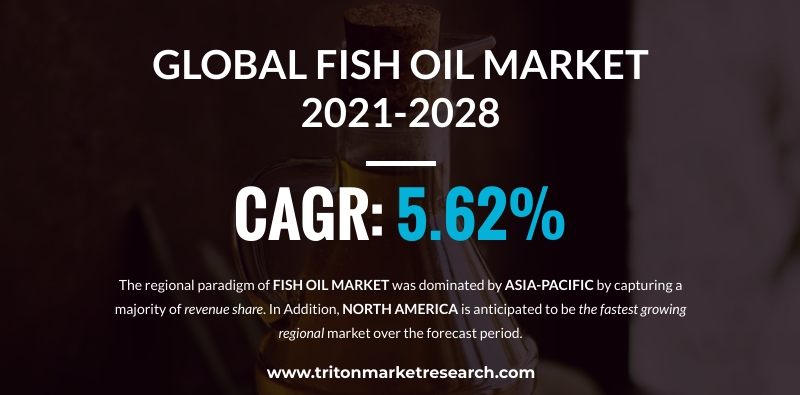A recent study by Triton Market Research titled ‘Global Fish Oil Market,’ covers the Global Analysis and Forecasts by Species (Mackerel, Anchovy, Cod, Sardines, Menhaden, Herring, Other Species), by Application (Supplements & Functional Food, Aquaculture [Salmon & Trout, Crustaceans, Cyprinids, Marine Fish, Eels, Tilapias, Other Aquaculture], Pharmaceuticals, Animal Nutrition, Other Applications), and Geography (North America, Europe, Asia-Pacific, Latin America, Middle East and Africa).
Request Free Sample of the Global Adhesives Market Report @ https://www.tritonmarketresearch.com/reports/fish-oil-market#request-free-sample
The report estimates the global fish oil market to showcase a CAGR of 5.62% during the forecast years 2021-2028, generating a revenue worth $2623.19 million by 2028. It is also expected to exhibit a CAGR of 3.41%, amounting to 1141.34 kilotons in volume by 2028.
Fish oil offers nutritional benefits. It consists of EPA (Eicosapentaenoic acid) and DHA (Docosahexaenoic acid). These are omega-3 fatty acids that are extremely beneficial to health. This factor is fuelling the growth of the fish oil industry.
The growing demand for the consumption of omega-3 fatty acids has increased the consumption of fish oil for manufacturing pharmaceuticals and nutraceuticals. However, this growing consumption of fish oil is creating a supply threat for aquaculture feed. Moreover, owing to the adverse environmental conditions and regulations imposed on fishing, companies in this market are unable to bridge the demand-supply gap. Therefore, continuous price fluctuations in the fish oil industry are expected to hinder the growth of this market.
The market for fish oil is bifurcated into species and application. Based on species, it is divided into mackerel, anchovy, cod, sardines, menhaden, herring, and other species. Whereas, based on application, it is categorized into supplements & functional food, aquaculture, pharmaceuticals, animal nutrition, and other applications. The aquaculture sub-segment is further divided into salmon & trout, crustaceans, cyprinids, marine fish, eels, tilapias, and other aquaculture.
The Asia-Pacific is the largest market for adhesives in the world, and holds the highest share. It is expected to continue its reigning position in the forecasting years. The APAC is also the largest consumer of fish oil, globally. Over 60% of fish oil produced across the globe is consumed in this market, particularly in China. Since China is not a major fish oil producer, it imports various grades of crude fish oil from nations like Chile, Peru, and Vietnam. It then processes the same further, so that it can be used for various human and animal consumption.
Triplenine Group A/S, GC Reiber Vivomega Oils, Pesquera Diamante SA, Marvesa Holdings NV, Copeinca AS, Pesquera Exalmar, Royal DSM NV, Lysi Hf, FF Skagen A/S, Croda International Plc, Omega Protein Corporation, Colpex International, FMC Corporation, Corpesca SA, and BASF SE are the well-known players in the fish oil market.
Purchase this Report @ https://www.tritonmarketresearch.com/reports/fish-oil-market#purchase-option
Question & Answer: Fish Oil Market
Question 1: What factor is fuelling the growth of the fish oil industry?
Answer: Fish oil offers nutritional benefits. It consists of EPA (Eicosapentaenoic acid) and DHA (Docosahexaenoic acid). These are omega-3 fatty acids that are extremely beneficial to health. This factor is fuelling the growth of the fish oil industry.
Question 2: What factors are expected to hinder the growth of the fish oil market?
Answer: The growing demand for the consumption of omega-3 fatty acids has increased the consumption of fish oil for manufacturing pharmaceuticals and nutraceuticals. However, this growing consumption of fish oil is creating a supply threat for aquaculture feed. Moreover, owing to the adverse environmental conditions and regulations imposed on fishing, companies in this market are unable to bridge the demand-supply gap. Therefore, continuous price fluctuations in the fish oil industry are expected to hinder the growth of this market.
Question 3: Which region is expected to dominate the global fish oil market?
Answer: The Asia-Pacific is the largest market for adhesives in the world, and holds the highest share. It is expected to continue its reigning position in the forecasting years. The APAC is also the largest consumer of fish oil, globally. Over 60% of fish oil produced across the globe is consumed in this market, particularly in China. Since China is not a major fish oil producer, it imports various grades of crude fish oil from nations like Chile, Peru, and Vietnam. It then processes the same further, so that it can be used for various human and animal consumption.
Question 4: Which are the well-known players in the fish oil market?
Answer: Triplenine Group A/S, GC Reiber Vivomega Oils, Pesquera Diamante SA, Marvesa Holdings NV, Copeinca AS, Pesquera Exalmar, Royal DSM NV, Lysi Hf, FF Skagen A/S, Croda International Plc, Omega Protein Corporation, Colpex International, FMC Corporation, Corpesca SA, and BASF SE are the well-known players in the fish oil market.
Related Report:
Global Dietary Supplement Market
The global dietary supplement market is set to show revenue growth in the forecasting years 2019 to 2028, generating $306.13 billion by 2028, while charting a CAGR of 8.91%.
There is a high demand for multivitamin tablets, which is one of the main driving forces of the market. Tablets are among the highly preferred forms of supplements, as they are available in various forms. Chewable tablets, enteric-coated tablets, effervescent tablets, sustained-release tablets, and sublingual & buccal tablets are the most common types of nutrition and dietary supplement tablets available in the market.
Manufacturing tablets is relatively cheap. Plus, they are widely accepted by patients across all age groups. Further, the shelf life of these dosage forms is higher than that of liquid and powder forms. Another benefit is that tablets can be manufactured in numerous shapes and sizes, and they also have higher absorption rates. All these factors have led to a surge in the demand for dietary supplements.
Media Contact
Company Name: Triton Market Research
Contact Person: Matt Dixson
Email: Send Email
Phone: +44 7441 911839
Address:196, wards wharf approach London E16 2EQ
Country: United Kingdom
Website: https://www.tritonmarketresearch.com/

